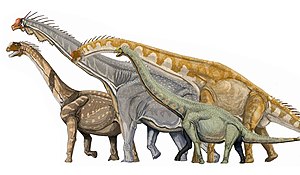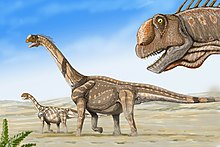Macronaria
| Macronaria | ||||||||||||
|---|---|---|---|---|---|---|---|---|---|---|---|---|

Various macronaria; Camarasaurus on the left (brown), Brachiosaurus in the background (gray), Giraffatitan in the middle (yellow), Euhelopus in the foreground (green) |
||||||||||||
| Temporal occurrence | ||||||||||||
| Middle Jurassic to Upper Cretaceous ( Bathonian to Maastrichtian ) | ||||||||||||
| 168.3 to 66 million years | ||||||||||||
| Locations | ||||||||||||
| Systematics | ||||||||||||
|
||||||||||||
| Scientific name | ||||||||||||
| Macronaria | ||||||||||||
| Wilson & Sereno , 1998 |
The Macronaria ( Gr .: "big noses") are a diverse group of sauropod dinosaurs . They include primitive forms such as Camarasaurus , Brachiosaurus, and Euhelopus, as well as the advanced Titanosauria . Thus they form the second main line of the Neosauropoda next to the Diplodocoidea .
Period and spread
The earliest undoubted representatives of Macronaria come from the Upper Jurassic and include Brachiosaurus and related forms, Camarasaurus and the possible early Titanosauria Janenschia . Since such a diverse Macronaria fauna already appeared in the Upper Jurassic, it is assumed that the origin of the group lies in the Central Jurassic . This hypothesis is supported by finds of footprints from the Middle Jurassic, which probably belonged to representatives of the Macronaria.
The last Macronaria belong to the group of Titanosauria and include, for example, Opisthocoelicaudia and Alamosaurus . These genera did not become extinct until mass extinction at the Cretaceous-Tertiary boundary about 66 million years ago, along with all other non-avian dinosaurs. This made the Macronaria the last surviving group of sauropods.
Macronaria fossils have been found on every continent with the exception of Antarctica .
features
The limbs of primitive Macronaria such as Brachiosaurus and Euhelopus were longer than those of other sauropods. In addition, the front legs were significantly elongated relative to the hind legs, which is partly due to an elongated metacarpal . In Brachiosaurus , the front legs were even longer than the rear legs. Thanks to these adjustments, the shoulder was at a greater height, which increased the maximum grazing height. These original Macronaria could therefore have specialized in higher-lying food sources - in contrast to the Diplodocoidea , which showed short front legs and thus a lower shoulder, which probably means that these sauropods mainly took up low-growing vegetation.
Systematics
External system
The Macronaria is a clade within the Sauropoda. The sister taxon is the Diplodocoidea . The cladogram shows the relationships (simplified from Weishampel, Dodson and Osmólska, 2004):
| Sauropoda |
|
||||||||||||||||||||||||||||||||||||
|
|
Internal system
The Macronaria consists of two main groups: the family Camarasauridae and the clade Titanosauriformes . The Titanosauriformes is divided into the Brachiosauridae and the Titanosauria . The genus Brontomerus is of an unclear position within Macronaria .
-
Macronaria
- Abrosaurus
- Family Camarasauridae
-
Titanosauriformes
- Australodocus
- Baotianmansaurus
- Europesaurus
- Fusuisaurus
- ? Huabeisaurus
- Qiaowanlong
- ? Venenosaurus
- Brachiosauridae family
- Family Huanghetitanidae
-
Somphospondyli
- Family Euhelopodidae
- Daxiatitan
- Dongbeititan
- Dongyangosaurus
- Erketu
- Titanosauria
|
Cladogram simplified from Weishampel, Dodson and Osmólska, 2004:
|
swell
literature
- Paul Upchurch : The Phylogenetic relationships of sauropod dinosaurs. In: Zoological Journal of the Linnean Society. Vol. 124, No. 1, 1998, ISSN 0024-4082 , pp. 43-103, doi : 10.1111 / j.1096-3642.1998.tb00569.x .
Individual evidence
- ^ Gregory S. Paul : The Princeton Field Guide To Dinosaurs. Princeton University Press, Princeton NJ et al. 2010, ISBN 978-0-691-13720-9 , pp. 194-213, online .
- ↑ a b Jeffrey A. Wilson: An Overview of Titanosaur Evolution and Phylogeny. In: Fidel Torcida Fernández-Baldor, Pedro Huerta Hurtado (eds.): Actas de las III Jornadas Internacionales sobre Paleontología de Dinosaurios y Su Entorno. = Proceedings of the 3rd International Symposium about Paleontology of Dinosaurs and their Environment Paleontología de dinosaurios y su entorno. Salas de los Infantes (Burgos, España), 16 al 18 de septiembre de 2004. Colectivo arqueológico-paleontológico de Salas, Salas de los Infantes (Burgos, España) 2006, ISBN 84-8181-227-7 , pp. 169-190 .
- ^ Matthew T. Carrano: The Evolution of Sauropod Locomotion - morphological diversity of a secondarily quadrupedal radiation. In: Kristina Curry Rogers, Jeffrey A. Wilson: The Sauropods. Evolution and Paleobiology. University of California Press, Berkeley CA et al. 2005, University of California Press, ISBN 0-520-24623-3 , pp. 229-251.
- ^ A b Paul Upchurch, Paul M. Barrett , Peter Dodson : Sauropoda. Systematics and Evolution. In: David B. Weishampel , Peter Dodson, Halszka Osmólska (eds.): The Dinosauria . 2nd edition. University of California Press, Berkeley CA et al. 2004, ISBN 0-520-24209-2 , pp. 295-314.
- ↑ John A. Whitlock: Re-evaluation of Australodocus bohetii, a putative diplodocoid sauropod from the Tendaguru Formation of Tanzania, with comment on Late Jurassic sauropod faunal diversity and palaeoecology. In: Palaeogeography, Palaeoclimatology, Palaeoecology. Vol. 309, No. 3/4, 2011, ISSN 0031-0182 , pp. 333-341, doi : 10.1016 / j.palaeo.2011.07.001 .
- ↑ Xingliao Zhang, Junchang Lü, Li Xu, Jinhua Li, Li Yang, Weiyong Hu, Songhai Jia, Qiang Ji, Chengjun Zhang: A New Sauropod Dinosaur from the Late Cretaceous Gaogou Formation of Nanyang, Henan Province. In: Acta Geologica Sinica. English edition. Vol. 83, No. 2, 2009, ISSN 1000-9515 , pp. 212-221, doi : 10.1111 / j.1755-6724.2009.00032.x .


